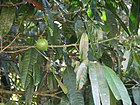Note: This is a project under development. The articles on this wiki are just being initiated and broadly incomplete. You can Help creating new pages.
Difference between revisions of "Garcinia xanthochymus"
(→Nutritional components) |
|||
| (One intermediate revision by the same user not shown) | |||
| Line 32: | Line 32: | ||
===Nutritional components=== | ===Nutritional components=== | ||
| − | Garcinia xanthochymus Contains the Following nutritional components like - Vitamin-B and C; Phenolic compounds, Fukugetin, Fukugiside, Glycoside, Xanthones - garcinenone; Magnesium, Manganese, Potassium<ref name=" | + | Garcinia xanthochymus Contains the Following nutritional components like - Vitamin-B and C; Phenolic compounds, Fukugetin, Fukugiside, Glycoside, Xanthones - garcinenone; Magnesium, Manganese, Potassium<ref name="Forest foods of Western Ghat"/> |
==Habit== | ==Habit== | ||
| Line 77: | Line 77: | ||
<ref name="How to plant/cultivate">[http://tropical.theferns.info/viewtropical.php?id=Garcinia+xanthochymus Cultivation]</ref> | <ref name="How to plant/cultivate">[http://tropical.theferns.info/viewtropical.php?id=Garcinia+xanthochymus Cultivation]</ref> | ||
<ref name="Uses">Indian Medicinal Plants by C.P.Khare</ref> | <ref name="Uses">Indian Medicinal Plants by C.P.Khare</ref> | ||
| − | <ref name=" | + | <ref name="Forest foods of Western Ghat">"Forest food for Northern region of Western Ghats" by Dr. Mandar N. Datar and Dr. Anuradha S. Upadhye, Page No.82, Published by Maharashtra Association for the Cultivation of Science (MACS) Agharkar Research Institute, Gopal Ganesh Agarkar Road, Pune</ref> |
</references> | </references> | ||
Latest revision as of 13:12, 27 October 2021
Garcinia xanthochymus is an evergreen tree with more or less horizontal branches and a dense pyramidal crown. It can grow 8 - 15 metres tall. It has a short, straight bole. The tree is harvested from the wild, and is also cultivated and semi-cultivated, for its edible fruit and dyestuff.
Contents
- 1 Uses
- 2 Parts Used
- 3 Chemical Composition
- 4 Common names
- 5 Properties
- 6 Habit
- 7 Identification
- 8 List of Ayurvedic medicine in which the herb is used
- 9 Where to get the saplings
- 10 Mode of Propagation
- 11 Cultivation Details
- 12 Commonly seen growing in areas
- 13 Photo Gallery
- 14 References
- 15 External Links
Uses
[[:Category:Ayurvedic Herbs known to be helpful to treat |]], [[:Category:Ayurvedic Herbs known to be helpful to treat |]], [[:Category:Ayurvedic Herbs known to be helpful to treat |]].[1]
Food
Garcinia xanthochymus can be used in Food. Ripe fruits are eaten raw. Pulp is also used to make sharbat (soft drink)[2].
Parts Used
Chemical Composition
Common names
| Language | Common name |
|---|---|
| Kannada | Devajarige |
| Hindi | Jharambi |
| Malayalam | Anavaya |
| Tamil | Paccilai |
| Telugu | Cikatimranu |
| Marathi | |
| Gujarathi | |
| Punjabi | |
| Kashmiri | |
| Sanskrit | Bhavishya |
| English | Mysore Gamboge, Sour mangosteen |
Properties
Reference: Dravya - Substance, Rasa - Taste, Guna - Qualities, Veerya - Potency, Vipaka - Post-digesion effect, Karma - Pharmacological activity, Prabhava - Therepeutics.
Dravya
Rasa
Guna
Veerya
Vipaka
Karma
Prabhava
Nutritional components
Garcinia xanthochymus Contains the Following nutritional components like - Vitamin-B and C; Phenolic compounds, Fukugetin, Fukugiside, Glycoside, Xanthones - garcinenone; Magnesium, Manganese, Potassium[2]
Habit
Identification
Leaf
| Kind | Shape | Feature |
|---|---|---|
Flower
| Type | Size | Color and composition | Stamen | More information |
|---|---|---|---|---|
| {{{5}}} |
Fruit
| Type | Size | Mass | Appearance | Seeds | More information |
|---|---|---|---|---|---|
Other features
List of Ayurvedic medicine in which the herb is used
Where to get the saplings
Mode of Propagation
Cultivation Details
A plant of the hot, humid tropics, where it is found at elevations up to 1,000 metres[5]. Garcinia xanthochymus is available through February-May[2].
Commonly seen growing in areas
Dense humid forests, On hills.
Photo Gallery
References
- ↑ Indian Medicinal Plants by C.P.Khare
- ↑ 2.0 2.1 2.2 "Forest food for Northern region of Western Ghats" by Dr. Mandar N. Datar and Dr. Anuradha S. Upadhye, Page No.82, Published by Maharashtra Association for the Cultivation of Science (MACS) Agharkar Research Institute, Gopal Ganesh Agarkar Road, Pune
- ↑ [Chemistry]
- ↑ [Morphology]
- ↑ Cultivation
External Links
- Ayurvedic Herbs known to be helpful to treat
- Herbs with Fruits used in medicine
- Herbs with common name in Kannada
- Herbs with common name in Hindi
- Herbs with common name in Malayalam
- Herbs with common name in Tamil
- Herbs with common name in Telugu
- Herbs with common name in Sanskrit
- Herbs with common name in English
- Habit - Evergreen tree
- Index of Plants which can be propagated by Seeds
- Herbs that are commonly seen in the region of Dense humid forests
- Herbs that are commonly seen in the region of On hills
- Herbs
- Pages without herbs images





